A Digital Day Trip through the Ah-Tah-Thi-Ki Museum Virtual Tour
Big Cypress Seminole Indian Reservation, Fla. (January 28, 2022) – Ah-Tah-Thi-Ki means “a place to learn, a place to remember.” Tucked into the Big Cypress Reservation, the Ah-Tah-Thi-Ki Museum is so much more than just a destination. One of the biggest challenges over the last two years has been providing a space for learning and remembrance of the Seminole Story safely. The Museum reopened to the public on August 21st, 2021, but closed again in late December for the health and safety of the Tribal community, staff, and potential guests. Be sure to check out the Museum’s social media pages and website for updates!
But, exciting changes are in the works for the Ah-Tah-Thi-Ki Museum moving forward. Within the next few weeks, the Museum will be taking reservations for small school groups to experience the exhibits in person (groups must be 20 or less, and will be split into two groups.) Additionally, private guided virtual tours will be available for school groups, subject to staff availability. If you would like to access either of these opportunities, please fill out this form to subscribe to updates about Museum activities!

Online, the Ah-Tah-Thi-Ki website hosts a fully interactive 3D virtual tour. From the comfort of anywhere you can check out the exhibits, watch videos, and even walk the boardwalk. When meandering through the virtual tour, make sure to turn your sound on! Immerse yourself in the sounds of the Everglades as you click through the arrows to navigate through the Museum. You will be able to pan 360 degrees around each space, and zoom in and out to see all that each gallery has to offer. There are four videos within the tour: the Orientation film, Coontie, Canoe Carving, and Alligator Wrestling. Below you can see an overview map of the Museum exhibits and main features. As you navigate the virtual space try and orient yourself in the Museum and make sure you don’t miss anything!

You begin your virtual tour exactly like you would in person – at the Museum entrance, right next to the campfire. As you enter and pass by the admissions desk, you can peruse the Museum store to the right. While you can’t shop the physical store at the moment, you can visit the online Museum Store for books, clothes, jewelry, and more.
The Orientation Theatre and Nook
If you travel to the left, you will first enter the Orientation Theatre and then the galleries. Check out the “We Seminoles” orientation video to introduce yourself to the Museum and the Seminole Tribe of Florida! Directly outside the Theatre, view featured selections from the Museum collection in the “Kaa-Ha-Yat-Le /Our Everglades” nook. One of these is a three-panel painting titled “Everglades Scene with Seminole Camp” by Noah Billie. It depicts two Seminole men launching a canoe into the water. This, and many other pieces featured, are all accessible to look at through the Museum Online Collections. Due to online access, a wide variety of Seminole art, historic objects, and more can be explored at your own pace. With over 180,000 objects, there is an opportunity for everyone to learn and experience Seminole culture and history digitally. (Please note that the virtual tour was created in 2020 and exhibits in the temporary galleries may differ from current exhibitions.)
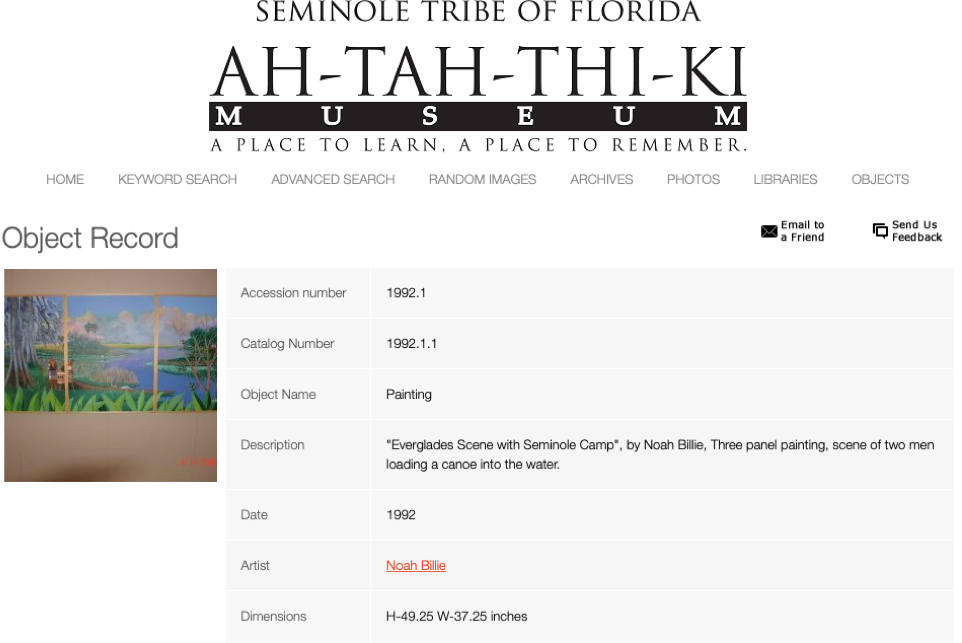
Online record for “Everglades Scene with Seminole Camp” by Noah Billie as it appears in the ATTK Museum Online Collection.
From the Land
Continuing your journey through the museum, the “From The Land” exhibit showcases the strong connection between nature and Seminole culture. The permanent galleries highlight Seminole life in the 1890s. Food, tools, building materials, and clothing were all dependent on the bounty of the Everglades. Watch the imbedded “Coontie” video to learn about an important Seminole foodstuff and how it is processed. In addition to harvesting from the land, Seminoles established relationships thru trading posts that were set up throughout south Florida. This exhibit boasts a replication of the Stranahan House—a trading post on the New River in Fort Lauderdale, FL that still stands today as a history museum.
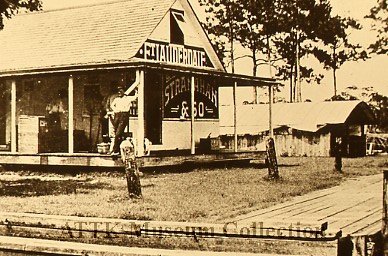
“The Stranahan House – A Site History”. Presentation slide #14, a sepia photograph of the Stranahan store, ca. 1894. Courtesy of the ATTK Museum Collection
The Camp
The center of the Museum exhibit space, “The Camp,” shows the heart of traditional Seminole day to day life. A number of chickees, the Miccosukee word for house, circle the space. Seminoles used separate chickees for different daily tasks. Instead of cooking and sleeping in the same area, there would be a sleeping and a cooking chickee with separate functions.
In the center of the gallery three women gather around a fire preparing a daily meal. This fire would be maintained and tended for weeks at a time. Multiple generations would gather to share and eat with each other. Beyond the cooking chickee, you can see a family in their dugout canoe on their way to a trading post. Another highlight is the video “Seminole Moments: Canoe Carving,” which goes deeper into the rich history of wood and canoe carving. Featuring Pedro Zepeda, a Seminole artist and canoe carver, the video outlines the long history and cultural connection to dugout canoes. “As long as we have had Seminoles and trees together” says Zepeda “we have made canoes.”
Domestic scenes in the gallery are surrounded by objects from the Museum collection. Traditional Seminole clothing, a beaded bandolier bag, and wood carvings are all visible. Near the exit of this exhibit, a man’s bigshirt is installed in a glass case. Generally made of cotton with bands of patchwork and applique, below is another example from the Online Collection. Rich patchwork, bold fabrics, and skillful artistry dominate Seminole clothing. This iconic style has transitioned over time, but the core fashion is still very present today.
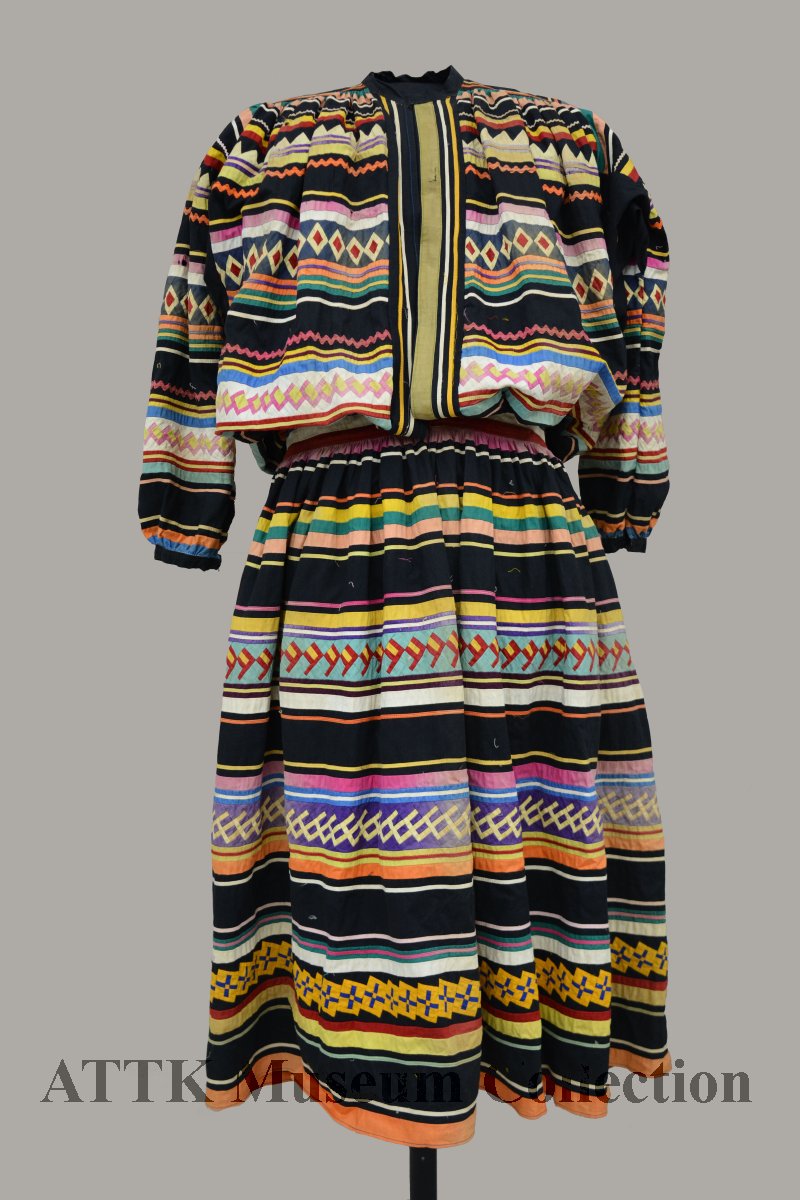
Men’s Bigshirt, Catalog number 1996.39.6, Photo Courtesy of the ATTK Museum Collection
Mosaic Gallery and Green Corn Exhibits
As you leave the Camp and pass along the Mosaic Gallery, take a moment to appreciate the selection of student artwork in the Ahfachkee Student Art Exhibit. Featuring a wide range of abilities and ages, the students were inspired by a number of artistic styles while also making them their own. Three paper fish hang above the rest of the artwork. A personal favorite is the bold, eye-lashed goldfish, guarding the rest of the art from above. Through these pieces the children explore form, shape, and color in both 2D and 3D art.
In the Green Corn exhibit around the corner, turn your sound up! There is special audio in the Green Corn Ceremony, playing amongst a depiction of the Catfish Dance with 15 lifecast figures. Peek in on a stickball game across the aisle. Similar to lacrosse, stickball is played men against women and could be used to settle disputes. Traditionally only played at Green Corn Dance, stickball has deep cultural ties that continue today.
Alligator Wrestling
In the West Gallery, step under a thatched chickee roof to the Alligator Wrestling exhibit. Here you can learn more about how the Seminole relationship to alligators has changed and shifted over time. More about the biology of alligators is also outlined in this exhibit, and an alligator skull is resting along a shelf on one of the far walls. While interactive portions of the exhibit are not virtual, you can view alligator trivia to test your knowledge about these dynamic reptiles! The featured video is also sure to thrill, with stunning examples of Seminole alligator wrestling. Through heart pumping action, Seminole alligator wrestling melds tradition, tourism, and a lesson of respect. To learn more about the history of alligator wrestling, tourism, and the development of the exhibit, please visit this previous blog post.
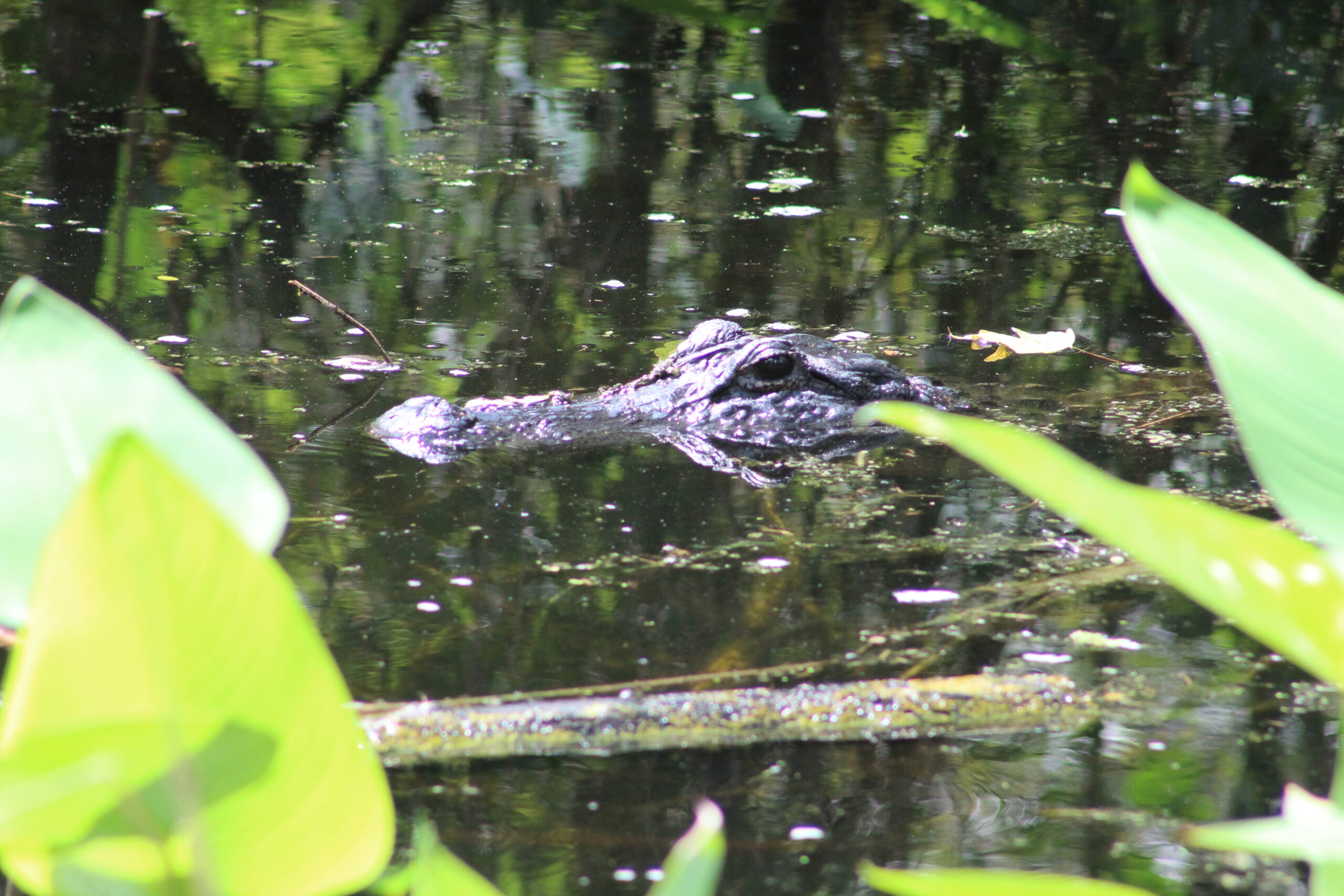
Sally the Gator, Swimming in the Cypress Dome at ATTK, Courtesy of Ah-Tah-Thi-Ki
The Village
Much like the in-person experience, the virtual tour isn’t confined to just the Museum walls. As you may have noticed through your self-guided virtual tour, almost every exhibit highlights how interconnected the Seminoles are to the Everglades. It makes perfect sense that the Museum experience spills out onto the boardwalk and the cypress dome it winds through. Following along the path outside you’ll see a re-creation of a famous “Pointing Man” sign. This sign points to the Village, the main focal point on the boardwalk loop. You can learn more about the history behind “Pointing Man” signs here in a previous blog post.
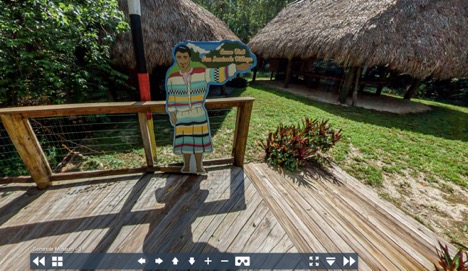
Pointing Man Sign along boardwalk directs you to the Village
As you walk through the Village, take in each chickee and imagine how it would look bustling with people and scented with campfire smoke. Museum visitors can meet Seminole artisans working on patchwork, beadwork, and other crafts, and even purchase some to take home.
The Hunting Camp and Boardwalk
On the other side of the one-mile long board walk (but only a few virtual clicks away) is the Hunting Camp. The camp boasts a large multipurpose work space with drying hides and a dugout canoe. A few clicks more and you can follow the path back towards the Museum. In the picnic area, the beginnings of another dugout canoe lies unfinished in the shade of a chickee.
While we wish we could all visit in person, there is a wealth of online information and resources that the Ah-Tah-Thi-Ki Museum has to offer. The learning still continues through the Museum blog, the online collections, this virtual tour, and of course the Museum Website. This Virtual Tour is just a starting point, and this overview is only a fraction of what there is to explore about Seminole culture and history. So, why not make the Ah-Tah-Thi-Ki Museum the destination of a digital day trip and visit today?


Pingback: The First Seminole Tourist Camps - Florida Seminole Tourism